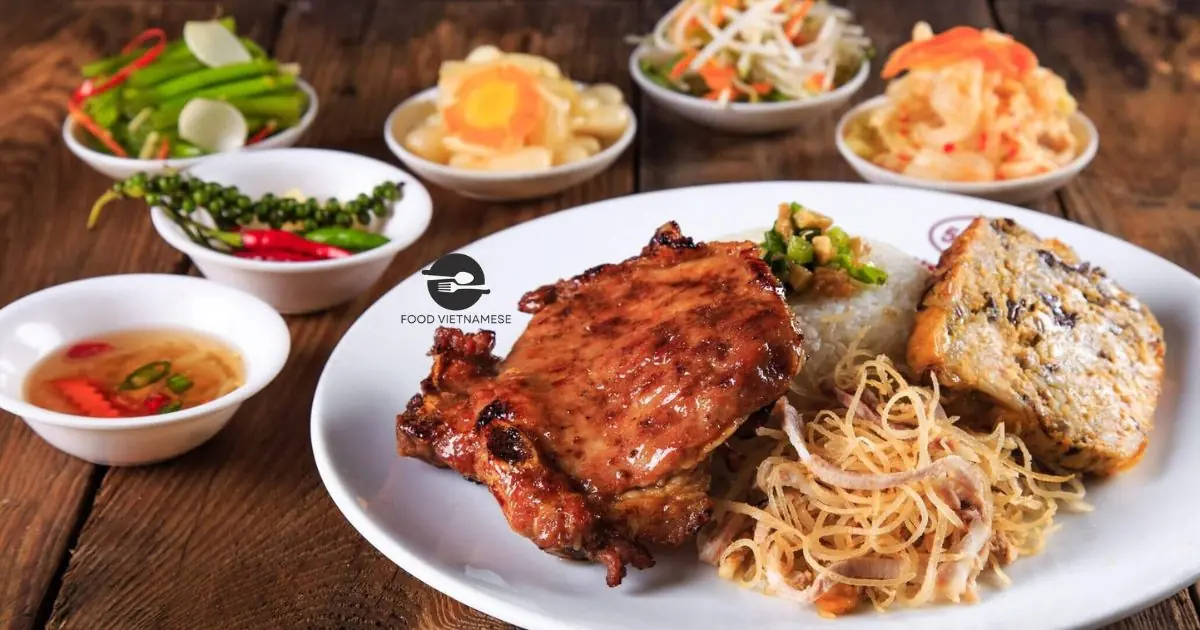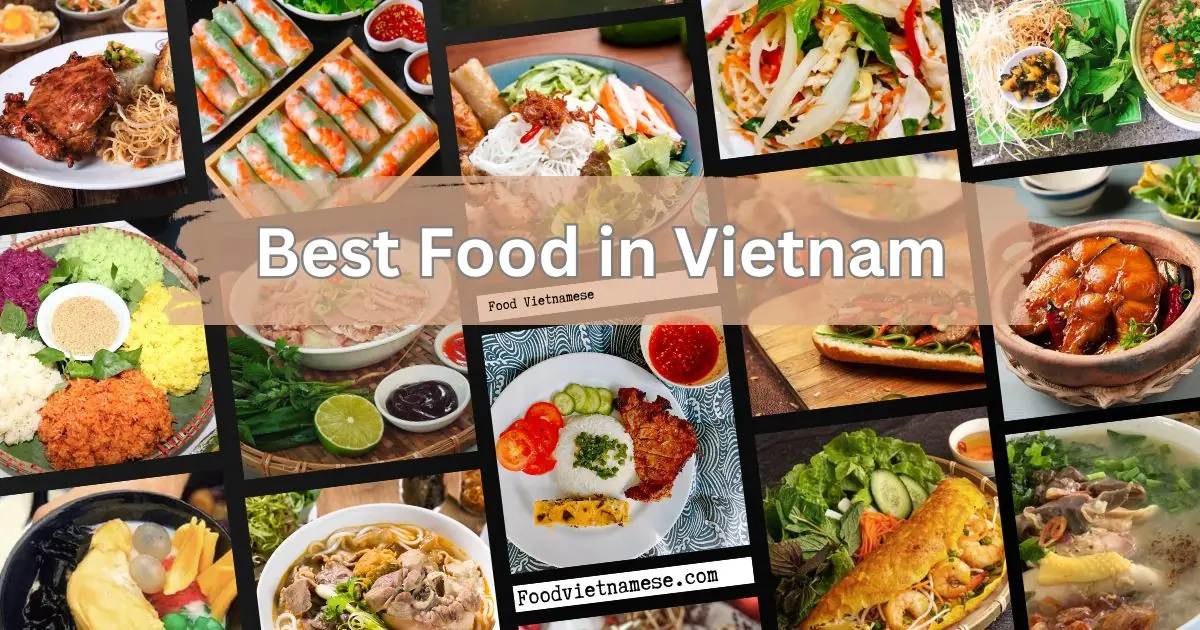Welcome to the vibrant and flavorful culinary world of Vietnam, where flavors dance on your palate and each dish tells a unique tale of the country’s rich history. From the bustling streets of Hanoi to the sun-kissed beaches of Da Nang, Vietnamese cuisine captivates food enthusiasts with its diverse offerings, regional delicacies, and intoxicating aromas. Let’s embark on a tantalizing journey to discover the best food in all of Vietnam.
Must-Try Delicacies of the Vietnamese Cuisine
1. Pho

- Origin: Huế, the former capital of Vietnam
- Ingredients: Rice vermicelli, thinly sliced beef, beef broth infused with lemongrass and fermented shrimp paste
- Taste: Rich, flavorful broth with tender beef and delicate noodles
- Variations: Phở Bò (beef noodle soup), Phở Gà (chicken noodle soup), Phở Dê (goat noodle soup)
- Fun Fact: Pho is Vietnam’s national dish and is enjoyed for breakfast, lunch, and dinner
- Experiential Tip: Visit the chaotic but authentic Pho Quynh in Hanoi for an unforgettable Pho experience.
2. Cơm tấm

- Origin: Mekong Delta
- Ingredients: Broken rice, grilled pork, minced pork and mushroom meatloaf, sunny-side-up egg, pickled vegetables, fish sauce
- Taste: Savory and hearty, with a combination of flavors and textures
- Variations: Cơm tấm Sài Gòn (Saigon style), Cơm tấm Hội An (Hội An style), Cơm tấm Đà Nẵng (Đà Nẵng style)
- Fun Fact: Cơm tấm originated as a way to utilize broken rice, which was considered a lower quality grain.
- Experiential Tip: Try the highly acclaimed Cơm Tấm Bụi Sưa in Ho Chi Minh City for a taste of traditional Cơm tấm.
3. Fresh Spring Rolls

- Origin: Various regions of Vietnam
- Ingredients: Rice paper, fresh ingredients (herbs, vegetables, rice noodles, shrimp, pork), dipping sauce
- Taste: Light, healthy, and refreshing, with a balance of textures and flavors
- Variations: Gỏi cuốn (fresh rice paper rolls), Bánh cuốn (steamed rice rolls), Nem cuốn (grilled rice paper rolls)
- Fun Fact: Fresh spring rolls are often served as an appetizer or side dish.
- Experiential Tip: Visit the popular Banh Xeo Lang Nuong in Da Nang for a wide variety of handmade fresh spring rolls.
4. Bánh Mì

- Origin: Hanoi, influenced by French colonial times
- Ingredients: Baguette, pâté, various meats, pickled vegetables, mayonnaise
- Taste: Savory, flavorful, and satisfying, with a unique blend of Vietnamese and French flavors
- Variations: Bánh Mì Huế (spicy and tangy), Bánh Mì Saigon (sweet and savory), Bánh Mì Nha Trang (with grilled pork)
- Fun Fact: Bánh Mì is a beloved street food in Vietnam and is often filled with local delicacies such as Cha Lua (Vietnamese sausage).
- Experiential Tip: Head to Bánh Mì Hòa Mã in Hanoi for a classic and affordable Bánh Mì experience.
5. Xôi

- Origin: Various regions of Vietnam
- Ingredients: Sticky rice, coconut milk, mung beans, savory fillings
- Taste: Glutinous, flavorful, and can be sweet or savory
- Variations: Xôi xéo (with mung beans), Xôi xoài (with mango), Xôi gà (with chicken)
- Fun Fact: Xôi is used in various dishes, including desserts, snacks, and even breakfast meals.
- Experiential Tip: Try the colorful and flavorful Xôi Yến in Hanoi for a variety of sweet and savory sticky rice options.
6. Bún riêu

- Origin: Hanoi
- Ingredients: Crabmeat, pork, tomatoes, watercress, vermicelli noodles, fermented shrimp paste
- Taste: Rich, flavorful broth with a complex blend of umami and tartness
- Variations: Bún riêu cua (with crabmeat), Bún riêu ốc (with snails), Bún riêu chay (vegetarian)
- Fun Fact: Bún riêu is said to have originated as a dish made from leftover fish scraps.
- Experiential Tip: Visit the popular Bún Riêu Gánh in Hanoi for a taste of authentic Hanoi-style Bún riêu.
Regional Flavors of Vietnamese Cuisine
1. Northern Region Cuisine – Hearty and Robust
- Characteristics: Strong flavors, generous use of spices, grilled dishes
- Popular Dishes: Phở, Bún chả, Cà phê trứng (egg coffee)
- Cultural Influences: French colonial era, Chinese culinary techniques
- Experiential Tip: Visit the ancient capital of Hanoi to immerse yourself in the authentic flavors of Northern Vietnamese cuisine.
2. Central Region Cuisine – Spicy and Tangy
- Characteristics: Bold flavors, use of citrus, seafood dishes
- Popular Dishes: Bún bò Huế, Cao lầu (Hoi An’s specialty noodle dish), Mì Quảng (quang noodles)
- Cultural Influences: Vietnamese royal cuisine, Cham and Indian culinary influences
- Experiential Tip: Embark on a culinary road trip along the scenic coastline of Central Vietnam to sample the diverse offerings of this region.
3. Southern Region Cuisine – Sweet and Savory
- Characteristics: Use of coconut milk, herbs and fresh produce, milder flavors
- Popular Dishes: Cơm tấm, Hủ tiếu (rice noodles), Canh chua (sour soup)
- Cultural Influences: Indigenous Vietnamese culinary traditions, Khmer and Chinese influences
- Experiential Tip: Explore the bustling city of Ho Chi Minh City and discover the vibrant street food scene that offers the quintessential flavors of Southern cuisine.
4. Highland Region Cuisine – Ethnic and Aromatic
- Characteristics: Unique seasonings, use of bamboo and banana leaves, grilled meats
- Popular Dishes: Cơm lam (bamboo rice), Canh gà đỗ đen (northern chicken stew), Thắng cố (horse meat stew)
- Cultural Influences: Indigenous tribal recipes, French colonial influences
- Experiential Tip: Venture into the beautiful Central Highlands of Vietnam to experience the diverse flavors of ethnic minority cuisines.
5. Coastal Region Cuisine – Seafood Delights
- Characteristics: Fresh seafood, citrus marinades, dipping sauces
- Popular Dishes: Fish sauce, Grilled prawns, Seafood salads
- Cultural Influences: Fishing and boat culture, Vietnamese culinary traditions
- Experiential Tip: Explore the picturesque coastal areas of Vietnam and indulge in the bounty of fresh seafood and local specialties.
Home Cooking Essentials for Vietnamese Dishes
- Essential Ingredients: Rice, soy sauce, fish sauce, lemongrass, garlic, ginger
- Cooking Equipment: Wok, steamer, rice cooker, mortar and pestle
- Authenticity Tips: Use traditional ingredients and techniques for the best results.
- Cultural Immersion: Learn about the culinary traditions of Vietnam for a deeper understanding of the cuisine.
- Local Markets: Visit local markets to purchase fresh ingredients and experience the vibrant culinary scene.
Food Safety Considerations
- Street Food: Exercise caution when consuming street food, especially in unhygienic areas.
- Questionable Meat: Avoid meat or seafood that appears spoiled or undercooked.
- Drinking Water: Drink bottled or purified water to prevent waterborne illnesses.
- Medical Advice: Consult with a healthcare professional before consuming certain foods if you have dietary restrictions or allergies.
- Food Preparation: Ensure proper food hygiene practices to minimize the risk of contamination.
FAQs
Q1: What is the most famous Vietnamese dish? A1: Phở, a noodle soup with beef or chicken, is arguably the most famous Vietnamese dish, enjoyed worldwide for its flavorful broth and tender meat.
Q2: Are Vietnamese dishes spicy? A2: The spiciness of Vietnamese dishes varies depending on the region and personal preferences. While Central Vietnamese cuisine tends to be spicier, you can adjust the level of spice in most dishes to suit your palate.
Q3: What is the national drink of Vietnam? A3: The national drink of Vietnam is Cà Phê Đá, a Vietnamese iced coffee popular for its robust flavor and refreshing nature.
Q4: Is Vietnamese cuisine healthy? A4: Vietnamese cuisine is generally considered healthy, as it incorporates fresh ingredients, herbs, vegetables, and lean proteins. The use of steamed dishes and grilling methods also contributes to its nutritional value.
Q5: How much does it cost to eat in Vietnam? A5: The cost of eating in Vietnam varies widely depending on the type of establishment, location, and level of luxury. Street food and local markets offer affordable options, while mid-range restaurants and high-end tourist areas may have higher prices.
Conclusion:
Vietnam’s culinary landscape is as diverse as it is enticing, a tapestry of bold flavors, regional nuances, and a cultural heritage etched in every dish. From the iconic Phở to the refreshing Gỏi cuốn, Vietnamese cuisine captivates taste buds with its vibrant ingredients, harmonious blends, and culinary creativity. Whether you’re embarking on a culinary adventure in buzzing city streets or exploring the countryside’s hidden gems, prepare your palate for an unforgettable gastronomic experience.

